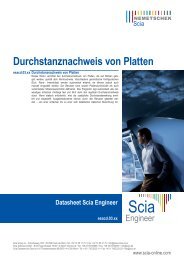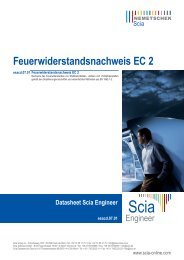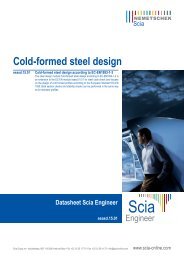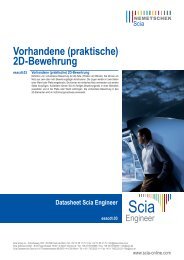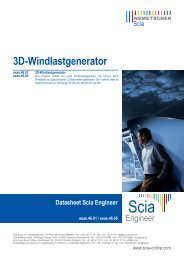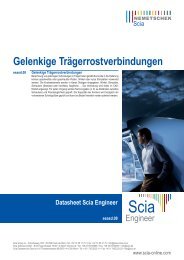Advanced Package Training Scaffolding 2011.1 - Scia-Software GbR
Advanced Package Training Scaffolding 2011.1 - Scia-Software GbR
Advanced Package Training Scaffolding 2011.1 - Scia-Software GbR
You also want an ePaper? Increase the reach of your titles
YUMPU automatically turns print PDFs into web optimized ePapers that Google loves.
10. The second order calculation<br />
Timoshenko<br />
42<br />
<strong>Advanced</strong> <strong>Training</strong><br />
The first method is the so called Timoshenko method (Th.II.O) which is based on the exact<br />
Timoshenko solution for members with known normal force. It is a 2 nd order theory with equilibrium on<br />
the deformed structure which assumes small displacements, small rotations and small strains.<br />
When the normal force in a member is smaller than the critical buckling load, this method is very solid.<br />
The axial force is assumed constant during the deformation. Therefore, the method is applicable when<br />
the normal forces (or membrane forces) do not alter substantially after the first iteration. This is true<br />
mainly for frames, buildings, etc. for which the method is the most effective option.<br />
The influence of the normal force on the bending stiffness and the additional moments caused by the<br />
lateral displacements of the structure (the P-∆ effect) are taken into account in this method.<br />
This principle is illustrated in the following figure.<br />
M(x) = Hx<br />
M(L) = HL<br />
First Order Theory<br />
The local P-δ effect will be regarded further in this course.<br />
M(x) = Hx + P δ + P Δx /L<br />
M(L)= HL + P Δ<br />
Second Order Theory<br />
If the members of the structure are not in contact with subsoil and do not form ribs of shells, the finite<br />
element mesh of the members must not be refined.<br />
The method needs only two steps, which leads to a great efficiency. In the first step, the axial forces<br />
are solved. In the second step, the determined axial forces are used for Timoshenko’s exact solution.<br />
The original solution was generalised in <strong>Scia</strong> Engineer to allow taking into account shear deformations.<br />
The applied technique is the so called ‘total force method’ or ‘substitution method’. In each iteration<br />
step, the total stiffness of the structure is adapted and the structure is re-calculated until convergence.<br />
This technique is illustrated in the following diagram.





